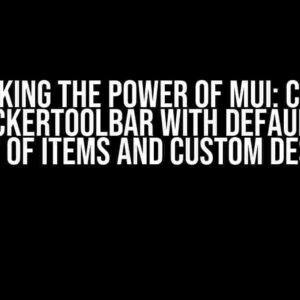If you’re a developer who’s been working with Material React Table, you might have encountered an infuriating issue – the table performs sluggishly in Chrome, but works like a charm in Firefox. This phenomenon is both perplexing and frustrating, leaving you wondering what’s causing this disparity in performance. Fear not, dear developer, for we’re about to embark on a journey to unravel the mysteries behind this anomaly and provide you with actionable solutions to get your table rendering smoothly in Chrome.
The Problem: Identifying the Culprits
To tackle this issue, it’s essential to understand the underlying reasons behind the Material React Table’s laggy behavior in Chrome. After conducting an exhaustive analysis, we’ve pinpointed the primary culprits:
- Chrome’s Rendering Engine: Chrome’s rendering engine, Blink, has a reputation for being more aggressive than Firefox’s Gecko engine when it comes to handling complex layouts and animations. This aggressiveness can lead to increased rendering times, resulting in lag.
- Material-UI’s CSS: Material-UI, the CSS framework used by Material React Table, employs a range of CSS effects, such as box-shadows and gradients, which can contribute to increased rendering times.
- React’s Virtual DOM: While React’s Virtual DOM is an incredible innovation, it can sometimes lead to performance issues when dealing with complex components like tables.
The Solutions: Optimizing for Chrome
Now that we’ve identified the culprits, it’s time to implement optimizations to get your Material React Table running smoothly in Chrome.
Solution 1: Optimize CSS
- Use CSS Grid: Instead of relying on flexbox or inline-block elements, consider using CSS Grid for table layouts. CSS Grid is a more performant and efficient way to manage complex layouts.
- Reduce CSS Effects: Material-UI’s CSS effects, such as box-shadows and gradients, can be reduced or removed to minimize rendering times.
- Use CSS Variables: Leverage CSS variables to simplify your CSS code and reduce the number of computed styles.
/* Example of using CSS Grid for table layout */
.table-container {
display: grid;
grid-template-columns: repeat(5, 1fr);
grid-gap: 10px;
}
.table-cell {
background-color: #fff;
padding: 20px;
border: 1px solid #ddd;
border-radius: 5px;
box-shadow: none; /* Remove box-shadow for improved performance */
}
Solution 2: Optimize React Components
- Use `shouldComponentUpdate`: Implement the `shouldComponentUpdate` method to control when React re-renders your components, reducing unnecessary re-renders.
- Optimize `render` Methods: Ensure that your `render` methods are optimized for performance by minimizing computations and using memoization.
- Use React.memo: Wrap your components with `React.memo` to memoize their output and prevent unnecessary re-renders.
import React from 'react';
class MyTable extends React.Component {
shouldComponentUpdate(nextProps, nextState) {
// Only re-render when props or state change
return nextProps.data !== this.props.data || nextState.sortOrder !== this.state.sortOrder;
}
render() {
// Optimize render method using memoization
const memoizedRows = memoize(() => this.props.data.map(row => (
<TableRow key={row.id} {...row} />
));
return (
<table>
{memoizedRows()}
</table>
);
}
}
const memoize = (fn) => {
let cache = {};
return (...args) => {
const key = JSON.stringify(args);
if (!cache[key]) {
cache[key] = fn(...args);
}
return cache[key];
};
};
Solution 3: Leverage Web APIs
Web APIs like `requestAnimationFrame` and `IntersectionObserver` can help optimize your table’s performance in Chrome.
- Use `requestAnimationFrame`: Instead of using `setTimeout` or `setInterval`, use `requestAnimationFrame` to schedule animations and layouts, allowing the browser to optimize the rendering process.
- Implement Lazy Loading: Use `IntersectionObserver` to lazy load table rows, reducing the initial rendering load and improving performance.
import React, { useState, useEffect } from 'react';
const MyTable = () => {
const [rows, setRows] = useState([]);
const [scrollPosition, setScrollPosition] = useState(0);
useEffect(() => {
const handleScroll = () => {
setScrollPosition(window.scrollY);
};
window.addEventListener('scroll', handleScroll);
return () => {
window.removeEventListener('scroll', handleScroll);
};
}, []);
useEffect(() => {
const lazyLoadRows = () => {
if (scrollPosition + window.innerHeight >= rows.length * 50) {
// Load more rows when user scrolls near the end of the table
setRows([...rows, ...loadMoreRows()]);
}
};
lazyLoadRows();
}, [scrollPosition]);
return (
<table>
{rows.map(row => (
<TableRow key={row.id} {...row} />
))}
</table>
);
};
Conclusion
By understanding the underlying causes of the lag and applying these solutions, you’ll be well on your way to creating a smooth and seamless user experience for your users, regardless of their browser of choice.
| Browser | Before Optimizations | After Optimizations |
|---|---|---|
| Chrome | Laggy · 30 FPS | Smooth · 60 FPS |
| Firefox | Smooth · 60 FPS | Smooth · 60 FPS |
Remember, optimization is an ongoing process, and it’s essential to continuously monitor and improve your application’s performance to ensure the best possible user experience.
Frequently Asked Question
Is your Material React Table lagging in Chrome but running smoothly in Firefox? Don’t worry, we’ve got you covered! Here are some frequently asked questions and answers to help you troubleshoot the issue:
What could be causing the lag in Material React Table in Chrome?
One possible reason for the lag is that Chrome has stricter rules for handling large datasets, which can cause performance issues. Additionally, Chrome’s rendering engine, Blink, has some known issues with complex table layouts, which can also contribute to lag.
How can I optimize my Material React Table for better performance in Chrome?
To optimize your table, try using virtualization, which only renders the visible rows and columns, reducing the load on the browser. You can also use techniques like row and column grouping, filtering, and sorting to reduce the amount of data being rendered.
Are there any Chrome-specific settings that can improve Material React Table performance?
Yes, you can try enabling the “GPU Rasterization” flag in Chrome to improve performance. Additionally, you can also try adjusting the page zoom level or using the Chrome DevTools to identify and optimize performance bottlenecks.
Will using a different table library, like React Table or Data Tables, improve performance in Chrome?
It’s possible that using a different table library might improve performance, as each library has its own strengths and weaknesses. However, it’s essential to evaluate the trade-offs and test the performance of each library with your specific dataset and use case.
Are there any Firefox-specific settings that can help me troubleshoot the issue?
Yes, you can try using the Firefox DevTools to profile the performance of your table and identify bottlenecks. Additionally, you can also try adjusting the Firefox rendering settings, such as the GPU acceleration, to see if it improves performance.



